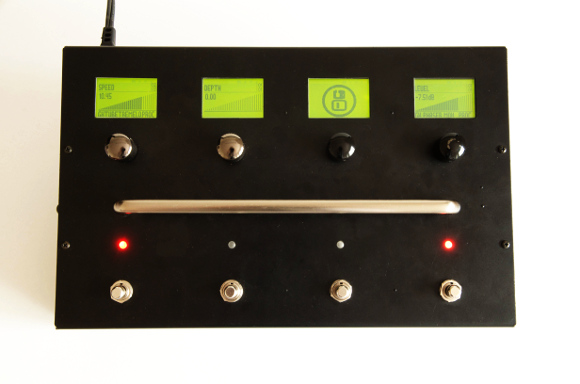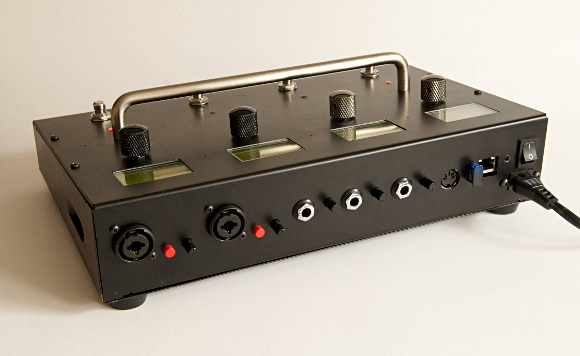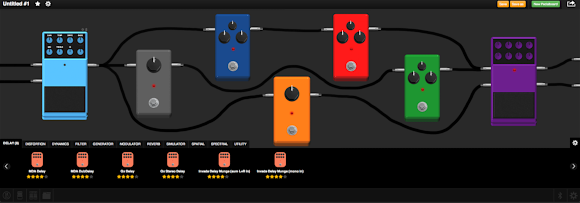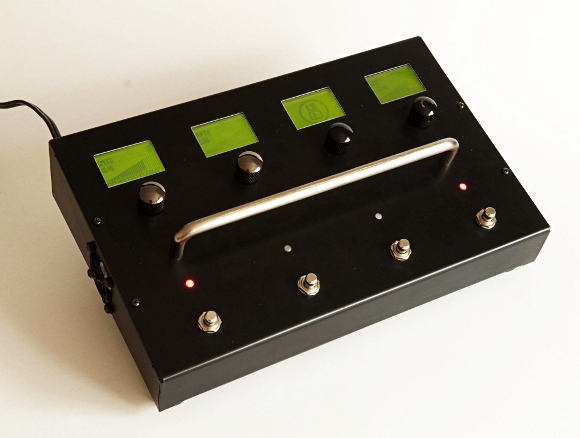Introducing MOD, Linux-based hardware sound FX processor
During Linux Audio Conference 2013 the MOD team presented their digital pedalboard that runs Linux and uses LV2 effects and instruments.
Outside it’s a typical pedalboard with 4 footswitches, 4 LEDs and 4 accompanying rotating knobs. The hardware inside is an Intel Atom N2800 1.8GHz with 2GB RAM and 8GB storage space and the internal audio interface uses 24bit / 48 kHz AD/DA.

The internal processing chain can be setup from a browser, for which you only need Bluetooth connection. You can also download new plug-ins from the cloud storage and share your presets with community. Here is a demonstration of setting up pitch shifter and an amp:
In a manner of speaking, we’ve seen a similar solution with Fender FUSE, but there’s a difference: the dashboard of MOD is built around a graph of plugins, where you can freely interconnect virtual stompboxes, run multiple ones in parallel, feed two different inputs from the same output and so on. MOD is also extensible (both the hardware and the software), and based on open technologies.
MOD Team is a fusion of two very small companies (AGR + Hacklab) and is comprised of 10 people. The project isn’t exactly new, but managed to stay out of public sight since its inception in 2010, until last week, when MOD was demonstrated during the Linux Audio Conference conference in Graz, Austria.
LGW asked a few questions to Gianfranco Ceccolini, the MOD product designer.
Gianfranco, I think a lot of people are wondering about three things: performance, quality, and price. Let’s start with the first one. The LAC paper you posted doesn’t mention latency for JACK. Did you measure it on heavy setups?
We ran tests on our audio interface, and it adds an average of 2ms to the JACK frameset latency. As you can change the JACK buffer size during runtime between 128 / 256 / 512 frames depending on the use you need and JACK runs at 44.1kHz, the total latencies are around 7.8, 13.6 and 25.2 ms respectively and we are continuously working towards getting those times smaller.
Your choice of Atom for an embedded system is interesting. Did you evaluate ARM?
Yes, we did, and we have plans for a smaller ARM based single board unit in the near future.
The choice of CPU is difficult as both architectures offer different benefits. The Intel offers a lot of CPU power and makes the development almost transparent to developers.

The ARM on the other hand offers floating point and DSP units, so plugins which made use of those could benefit a lot.
Depending on the public adoption we would like to have both versions available, and the cloud would serve both the Intel as the ARM plugins as well.
Do you intend to make it an open hardware project?
We are not sure yet. Our will is to have the whole system as open as possible, but on the other hand, we don’t want to be swallowed by some big corporation that thinks we just gave away all intellectual property. We are still analyzing, where the boundaries separating the opened from the closed are for us.
The screenshots I’ve seen are all using more or less simple plug-ins in terms of amount of controls. But what happens when you start using big fat synths like Calf Organ with tons of controls? Does your UI generator handle that well enough?
The generator is intended only for the simple plugins (the ones you fit on a stomp box). The idea is to have a well documented SDK to make it easy to build a custom GUI for the complex plugins, with ready made widgets for actuators and stuff.

For some of the “oficial” plugins – the ones we will officially support - we are also building custom interfaces, so developers will be able to use their GUI code as models for their own. The whole thing is HTML5 + CSS + Javascript, and that part is all open source.
How do you evaluate the quality of LV2 plug-ins before making them available via the cloud? What are they key factors you measure?
At this moment our choice is made upon the plugins popularity inside the Linux Audio community, and we are not being that rigorous.
The idea is to have a big set of plugins available. Depending on the the users response we shall allocate more resources on a particular plugin.
Some plugins need code enhancements, and some others just need a workable GUI, so our decision is to put them all online for users to choose, and from there we shall see where to put our resources.
How easy will it be to extend MOD? Is it technically possible to use something like CLAM Chordata on audio inputs and thus turn MOD into a guitar synthesizer like Roland GR-55?
Well, if it’s just a matter of software, technically, I’d say, yes. If that is feasible — it’s a whole new story. I’m very curious about the hacks people will do when they ssh into their MOD.

I use a GK-3 pickup on my guitar and connect to the MOD via the MIDI in to use it like a synthesizer with the appropriate plugins (Calf Monosynth, MDA piano, etc). This setup is very straightforward with our system, being all done using the GUI. The only drawback is the need for a MIDI interface between the MOD and the GK-3 pickup.
We’ve been researching some pitch tracking plugins to avoid the use of the GK-3, but haven’t found anything good enough yet. Taking a look at the CLAM Chordata, I think that if someone hacked it a bit, it might be possible to use it. One must remember that real time constraints exist.
You are now running a campaign to get the first 35 devices built for end-users. What’s the estimated price of a pedalboard from this first batch?
It shall be around US$1000 which is what you get with the two digit production scale and early adopter surplus. We want to make it as low as possible. Our bill of materials still changes more often we would like.
Do you think crowdfunding for your project isn’t applicable?
We are studying a way to make the second batch, this time — at a bigger production scale, using Kickstater.
Are you planning any substantial changes to the design of the device?
Yes, we are. The MOD Quadra has the specification to introduce the MOD concept to the market, at the same time it is possible to be built at a lower scales.
First things first: we need to have a bigger production scale. There are be lots of different directions we would like to take the MOD to. Better enclosure, richer LCDs, more audio channels, different sizes and amplifier / cabinet integration are some of the ideas.
You can follow further evolution of MOD via the product blog.
Patreon subscribers get early access to my posts. If you are feeling generous, you can also make a one-time donation on BuyMeACoffee.
